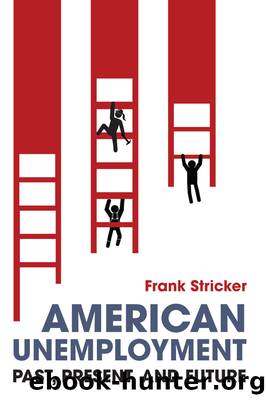American Unemployment: Past, Present, and Future by Frank Stricker

Author:Frank Stricker [Stricker, Frank]
Language: eng
Format: epub
Tags: Labor, Labor & Industrial Relations, United States, Political Science, Business & Economics, History, General
ISBN: 9780252052033
Google: nPzgDwAAQBAJ
Goodreads: 51987879
Publisher: University of Illinois Press
Published: 2020-05-01T00:00:00+00:00
Table 6.1 The Official Labor Force in April 2019
The employed: 156,645,000 + the unemployed: 5,824,000 =
The labor force: 162,469,000
5,824,000 unemployed divided by the labor force of 162,469,000 = a 3.6% unemployment rate.
Source: BLS, Employment SituationâApril 2019.
Debates and Revisions
Over the years, the official unemployment rate has often been debated. Federal agencies have not ignored criticisms, but they have been cautious. Disputes have ranged from hysterical and highly partisan to the serious and highly technical. In the late 1950s, things got rather heated. Employment had not recovered from the 1957â1958 recession; in fact, the economy sank into a second recession before full recovery. This became part of a conversation about above-average unemployment. Was the reason a lack of total economic demand or a specific cause, such as worker skill deficits or a long-term contraction of manufacturing?12
One pundit decided that the problem was simpler: the government was lying. In the Readerâs Digest, James Daniel claimed that government personnel were conspiring to exaggerate unemployment to âpush Uncle Sam into new federal spending programs and new controls over the economy.â Danielâs position was extreme but not unique. Other conservatives, too, wanted a lower unemployment count because they believed that most people could find a job and because higher unemployment justified more government spending and that was a threat to âfree enterprise.â Danielâs assault was not a serious analysis, but it may have been one factor that led to a scholarly review of the governmentâs methods. But not much changed at the BLS.13
In the later 1960s and in 1970, there were experiments that might have brought major revisions. In 1966, led by Secretary of Labor Willard Wirtz, the Department of Labor carried out a survey of inner-city âsubemploymentâ that generated very high numbers. This subemployment survey added part-timers who wanted full-time work, discouraged job-seekers who had stopped searching, an estimate for people typically missed in government surveys, and non-elderly employed people who earned below-poverty incomes. As discussed in chapter 3, the new estimates were two, three, and even four times the official unemployment rate for inner-city neighborhoods. But this pioneering effort to get a more realistic count of the unemployed and underemployed was not institutionalized. There was one similar effort, linked to the 1970 census, but nothing after that. Higher unemployment rates were not something presidents cared to sponsor.
But the numbers debate continued in the 1970s. In 1973, when official unemployment was 5.7 percent, scholars Bertram Gross and Stanley Moss claimed that the real unemployment rate was 25 percent when you included discouraged workers and millions of others who would seek work if there were enough jobs. In the recession of 1974â1975, the editors of the socialist Monthly Review claimed that real unemployment was one and a half times the official number. Around the same time, social scientists Frank Furstenberg and Charles Thrall challenged the governmentâs definition of being unemployed. They suggested that searching for a job and a stated desire for work were not adequate criteria because American culture was warped by a job rationing ideology.
Download
This site does not store any files on its server. We only index and link to content provided by other sites. Please contact the content providers to delete copyright contents if any and email us, we'll remove relevant links or contents immediately.
Zero to IPO: Over $1 Trillion of Actionable Advice from the World's Most Successful Entrepreneurs by Frederic Kerrest(4298)
Machine Learning at Scale with H2O by Gregory Keys | David Whiting(4184)
Never by Ken Follett(3794)
Harry Potter and the Goblet Of Fire by J.K. Rowling(3775)
Ogilvy on Advertising by David Ogilvy(3511)
Shadow of Night by Deborah Harkness(3304)
The Man Who Died Twice by Richard Osman(2997)
Book of Life by Deborah Harkness(2868)
The Tipping Point by Malcolm Gladwell(2827)
Will by Will Smith(2794)
0041152001443424520 .pdf by Unknown(2784)
My Brilliant Friend by Elena Ferrante(2774)
How Proust Can Change Your Life by Alain De Botton(2742)
Purple Hibiscus by Chimamanda Ngozi Adichie(2652)
How to Pay Zero Taxes, 2018 by Jeff A. Schnepper(2602)
Hooked: A Dark, Contemporary Romance (Never After Series) by Emily McIntire(2502)
Rationality by Steven Pinker(2291)
Borders by unknow(2229)
Can't Hurt Me: Master Your Mind and Defy the Odds - Clean Edition by David Goggins(2228)
